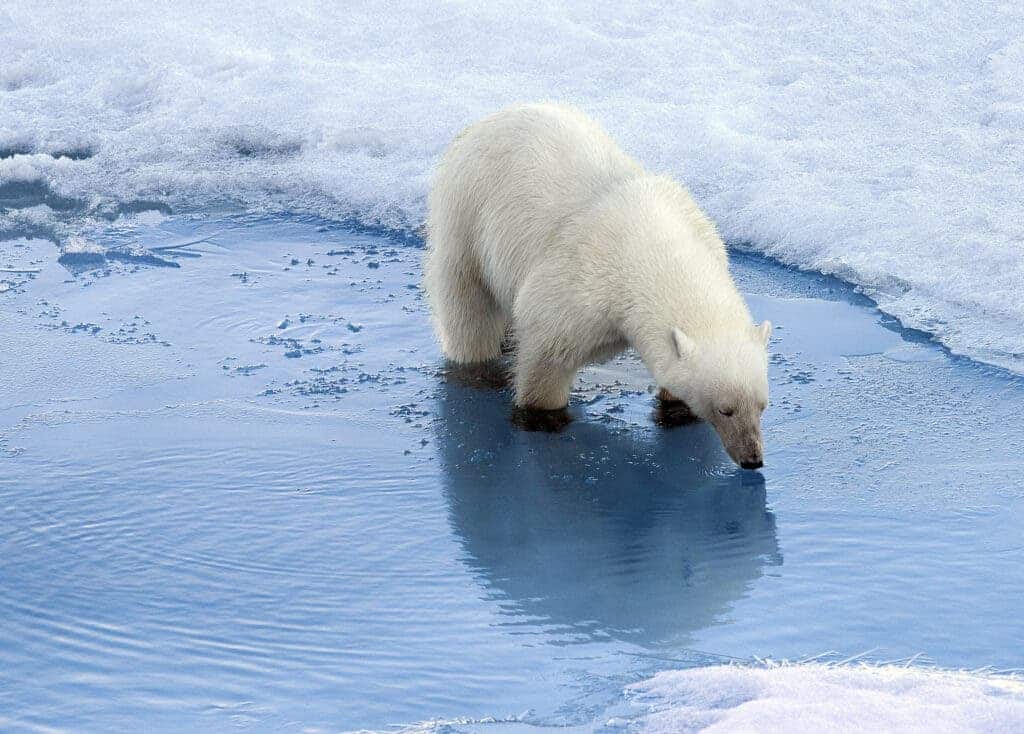The amount of energy required by polar bears and narwhals to survive in the warming Arctic has increased by 3-400% in recent decades, according to a new study — and it’s pushing them to extinction.

The Arctic has been melting at three times the global rate over the past 30 years, limiting the hunting grounds of apex predators. Unsurprisingly, Arctic animals are desperately struggling to cope with the changes.
Researchers Anthony Pagano and Terrie Williams explained that creatures such polar bears and narwals are particularly vulnerable to sea ice deterioration in the Arctic because of their hunting behaviors and their diet, as well as their physiological adaptations. These features make them excellently adapted to normal Arctic conditions, but are limiting their ability to adapt to the changing climate.
The Arctic is currently warming more than twice as fast as the rest of the planet on average. This is driven by declines in sea ice cover, leading to a sea ice-albedo feedback mechanism. These phenomena have resulted in declines in September Arctic sea ice at a rate of 13.3% per decade since 1979. The current record low happened in 2012, which was 49% lower than average.
Previous studies have shown that sea ice retreat is happening 3–9 days earlier per decade and sea ice advance 3–9 days later per decade. Additionally, winter sea ice extent has declined at a rate of 3.4% per decade since 2000. Forecasts anticipate the Arctic could be largely ice-free in summer by mid-century — which would be devastating for wild animals.
More energy
Pagano and Williams measured the energetic cost of movement specifically for polar bears and narwhals and found that major ice loss translated into a significant increase in energy consumption. Simply put, because of the changing conditions, the animals need to waste much more energy to hunt. The higher energy demand and the limitation of access to seals, one of their main sources of food, leave the animals more vulnerable to starvation.
In the case of polar bears (the largest land carnivores), their ability to catch ice seals has historically enabled them to meet their high metabolic demands. They are ambush hunters, waiting at seal breathing holes and catching them. But as the sea ice breaks are now breaking earlier and retreating, their chance of catching seals is significantly diminishing, the researchers wrote.
The polar bears are now relying much more on terrestrial food resources, which have considerably lower energetic densities and lower overall digestible energy. For example, they calculated that a polar bear would have to eat 1.5 caribou, 37 Arctic char, 74 snow geese, and 216 snow goose eggs to equal the digestible energy of an adult seal.
“The Arctic world is so much more unpredictable for these animals now,” Williams, a co-author of the report, told The Guardian. “With a finite amount of oxygen in their muscles and blood, we find that the narwhals budget their speed, depth, and duration of dives to match the capacity of their internal scuba tanks. One miscalculation could result in drowning.”
Meanwhile, the changes in ice cover with Arctic warming present a different energetic challenge for narwals. They obtain much of their annual energy intake during winter by diving for Greenland halibut (a type of flatfish). They rely on breathing holes in the ice to replenish their oxygen stores when finishing each dive. But changes to the sea ice have made the presence and stability of the holes less predictable.
The loss of sea ice has also resulted in a larger presence of killer whales – new apex predators in the Arctic marine ecosystem. They are one of the few aquatic animals know to attack and kill narwhals, affecting their behavior and distribution. Responding to the presence of the whales, the narwhals exhibit evasive movements towards areas of dense pack-ice or move to shallow waters.
For the researchers, the declines in polar bears and narwhals will lead to declines in other ice-dependent marine mammals and some of their principal prey, such as Arctic cod that rely on sea ice-associated zooplankton. The decline “is likely to alter trophic dynamics and thus lead to rapid changes in the entire Arctic marine ecosystem,” they conclude.
The study was published in the Journal of Experimental Biology.


